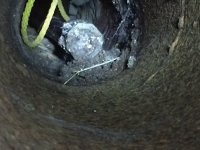Madscientistii
New Member
Hi Everyone,
I'm diagnosing a well issue. Long story short a splice broke in the supply line from the well to house. Introduced a lots of fines over the years... (don't ask, that's the long story.) I found the broken splice and repaired it.
We've been flushing the system for a couple of weeks now to remove the fines from the pressure tank. After about a week to week and half, the faucets begin burping out air. (Yes, I bled the air out the system once the splice was repaired)
The pressure tank, while old (wx-203 install date 1988), appears to be holding its charge pressure and no water is exiting the schrader valve . (we will probably replace tank anyway, since it doesn't seem to be clearing the fines)
After the pump kicks off, there is a slight drop in pressure on the system 1-3 psi, but after that, it holds.
There is a check valve at the pressure tank, but depending on what you read here at the forums, that should probably go away.
When the supply line from the well is disconnected from the pressure tank, there is a slow, but significant suction.
The well appears to be keeping up with recharge when looking down the pipe. Static level is about 20ft.
The pump may have been replaced in 1997. Looking down the well, the casing look bone dry.
Should there be any suction at all on the supply line from the well?
Does the suction on the supply line indicate a bad check/foot valve? A leak on the pipe in the well? (Air is getting in the system)
Do I really have to pull the pump and if so, do I need to replace pump or just replace pipe and check ?
Thank you for your insights.
I'm diagnosing a well issue. Long story short a splice broke in the supply line from the well to house. Introduced a lots of fines over the years... (don't ask, that's the long story.) I found the broken splice and repaired it.
We've been flushing the system for a couple of weeks now to remove the fines from the pressure tank. After about a week to week and half, the faucets begin burping out air. (Yes, I bled the air out the system once the splice was repaired)
The pressure tank, while old (wx-203 install date 1988), appears to be holding its charge pressure and no water is exiting the schrader valve . (we will probably replace tank anyway, since it doesn't seem to be clearing the fines)
After the pump kicks off, there is a slight drop in pressure on the system 1-3 psi, but after that, it holds.
There is a check valve at the pressure tank, but depending on what you read here at the forums, that should probably go away.
When the supply line from the well is disconnected from the pressure tank, there is a slow, but significant suction.
The well appears to be keeping up with recharge when looking down the pipe. Static level is about 20ft.
The pump may have been replaced in 1997. Looking down the well, the casing look bone dry.
Should there be any suction at all on the supply line from the well?
Does the suction on the supply line indicate a bad check/foot valve? A leak on the pipe in the well? (Air is getting in the system)
Do I really have to pull the pump and if so, do I need to replace pump or just replace pipe and check ?
Thank you for your insights.

